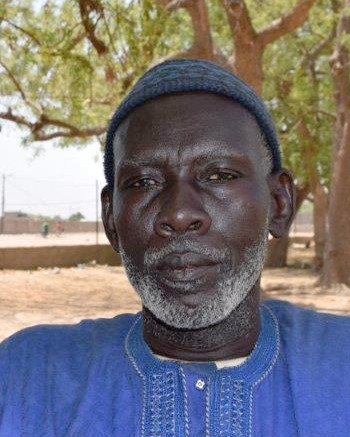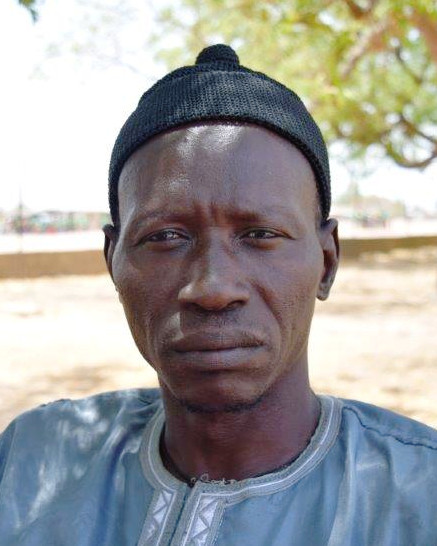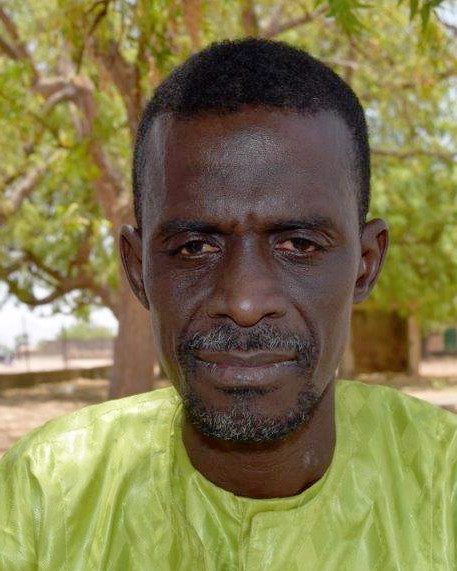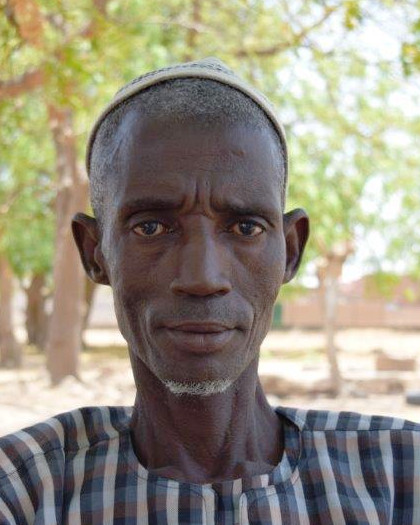As we continue our journey from the labs, factories and deal rooms where aflatoxin testing is done, Aflasafe manufactured and business deals made, just like farmers do, we crisscrossed between Senegal and The Gambia in search of what the ultimate users of Aflasafe have to say – the farmers. Having spoken to farmers in M’bollet Ba and Pakau Njogu in The Gambia, we then crossed both the River Gambia and the national frontier, over to Koungheul, Senegal, to hear about Aflasafe as seen by farmers who use it. Here is what Adji Fatou Seck, Mallick Ndao, Amath Sakho, Magueye Ba and Samba Sow had to say…

We’re doing our part; government must also step in and play its part in the anti-aflatoxin fight
Mr Adji Fatou Seck has been using Aflasafe since 2017, when he heard about aflatoxin in groundnuts and maize from BAMTAARE Services, the exclusive future Aflasafe manufacturers and current distributors in Senegal. Of the 25 hectares he farms, 15 are devoted to groundnuts, of which two hectares are Aflasafe-protected. He’s from a family of 15, some of whom are away.
“We learnt that if we used Aflasafe on groundnuts and maize, this would reduce aflatoxin in them, thereby protecting us from aflatoxin-induced liver cancer,” says Adji. “This solves a health issue, and BAMTAARE also pays a higher price for Aflasafe-treated groundnuts.”
And yet, Adji would not recommend Aflasafe to other farmers because there is no reward or incentive. But that does not blind him on its benefits nor – apparently – others. “During harvest-time, we hire extra hands to help. We’ve noticed that they tend to only eat the groundnuts from the small Aflasafe-protected patch, while avoiding the other groundnuts. It can only mean that they too have noticed a clear quality differentiation.”
“The women use Aflasafe-protected groundnuts to make peanut butter exclusively for home use: they don’t sell any of it”
And there’s more. “When people help you with harvesting and threshing the groundnuts, the women are paid in kind with groundnuts. The women go for the groundnuts in the Aflasafe-protected patch. They use them to make peanut butter exclusively for home use: they don’t sell any of it.”
Adji adds that he respects the contract with BAMTAARE under which he is obliged to sell to BAMTAARE the Aflasafe-protected groundnuts, in part, to pay in kind for the Aflasafe that BAMTAARE provides upfront as part of a package of inputs to farmers. “I would rather keep all the Aflasafe-treated groundnuts, but I honour the contract,” says Adji.
“It is imperative that the government step in and take up the Aflasafe programme … There is no market in Senegal for aflatoxin-safe groundnuts”
He would like to see the government play its regulatory role more firmly. “Were the government to decree that all farmers must use Aflasafe, then all the farmers would know about Aflasafe, and how and why to use it. What we have now is only a small Aflasafe programme. It is imperative that the government step in and take up the Aflasafe programme. This would see Aflasafe applied in every corner of Senegal where it is needed.”
With the current setup, Adji would not consider buying Aflasafe at a free-market price of XOF 10,000 (USD 17) for 10 kilos to protect one hectare, for a very simple but sound reason. “There is no market in Senegal for aflatoxin-safe groundnuts,” he laments.
And yet, indirectly, there is a market. At least for Aflasafe-treated groundnuts, even with matters as they are. Goulé Gueyé, BAMTAARE Deputy Managing Director, informs us that Sodefitex, the entity of which BAMTAARE is an affiliate, sells the aflatoxin-safe groundnuts it buys back from farmers in local markets, and has not yet exported any. “Purely on the market forces of grading and appearance, the Aflasafe-treated aflatoxin-safe groundnuts command a higher price on the local markets, by dint of being bigger, and better-looking – parameters the market already recognises and values,” he further reveals. However, at this point in time, BAMTAARE/Sodefitex does not test for aflatoxin when buying back groundnuts from farmers. The filters they use are: (1) to only pay the premium price when buying from Aflasafe-using farmers; and (2) the market parameters above for bigger and better grains.

We’re all at risk, and yet…
Mr Mallick Ndao is a beneficiary of BAMTAARE and IITA training on aflatoxin management with Aflasafe, and has been using the product since 2017, a year when his farm was used by the trainers for demonstration to his fellow farmers. Last year (2018), he worked with BAMTAARE’s seed programme. His 30-member family farms 30 hectares, of which more than half (17) are devoted to groundnuts.
He continues to use Aflasafe because of the premium price BAMTAARE offers for Aflasafe-protected groundnuts. But this is not the only reason. “I applied Aflasafe only on one side of my groundnuts. At harvest, there was a distinct difference. The side with Aflasafe had better and bigger grains, and a higher yield. And because I had a contract with BAMTAARE for a guaranteed buy-back, I had the assurance that my better groundnuts would have an above-market price.”
Mallick has recommended Aflasafe to his brother, who first applied it on one hectare. Having seen what Aflasafe does, his brother will continue to use Aflasafe.
“I would like to treat my entire farm with Aflasafe”
“I am happy with the premium price, which is above the government price,” reports Mallick. “But can the government expand the market for aflatoxin-safe groundnuts? I would like to treat my entire farm with Aflasafe and so sell all my produce at the premium price.”
And so, would Mallick buy Aflasafe at XOF 10,000 (USD 17) for 10 kilos to treat one hectare? His answer is interesting. “I actually requested for more Aflasafe last year to use outside the pilot programme. But even if I were to use it, there’s no other new market for my aflatoxin-safe groundnuts. And so, I would buy it, but only for groundnuts for my own home consumption, not for sale.”
Mallick decries the low awareness on aflatoxin yet it endangers everyone. He would like to see much more being done to raise awareness, particularly through community radio. Even so, that alone would not be enough, and Mallick proffers a pragmatic solution on how to connect high awareness with concrete action once the nation is put on aflatoxin alert countrywide. “If we want to cover the entire country with Aflasafe, then we must extend credit to farmers. It is a no-brainer which one a farmer will buy when faced with the choice between buying a bag of rice for the family to eat or a bag of Aflasafe, when there’s only money in hand for one but not for both.”
A little credit goes a long way, where there is a will but not a way

Mr Amath Sakho started using Aflasafe in 2018, when it was introduced to him by BAMTAARE’s extension service, with advice that he be part of their Aflasafe programme. His 12-member family farms 20 hectares, growing groundnuts on four, of which one hectare is Aflasafe-protected. They also grow maize, millet, watermelon and sesame.
“Along with the Aflasafe came seeds for short-cycle groundnuts. And so, these groundnuts matured before the rainy season. And yet at harvest, all the Aflasafe-protected groundnuts were clean and mould-free,” says Amath. “Usually, the humidity would result in mould. I also learnt about cancer caused by aflatoxin in groundnuts, and the protection that Aflasafe offers, lowering the risk of aflatoxin-related cancer.”
For Amath, he sees Aflasafe as also a fertiliser of sorts. “The yield noticeably improved. And even well before the harvest, after just one week after first applying Aflasafe, I could see the difference. The groundnuts with Aflasafe were growing a lot faster.”
Amath would – and indeed has – recommended Aflasafe to other farmers, without having to move an inch. “People were curious and interested when the saw me applying Aflasafe, and so they came to enquire. I told them about Aflasafe’s health benefits and BAMTAARE’s premium price.”
Amath’s wish would be for all farmers in Senegal to have access to Aflasafe and the premium price for aflatoxin-safe groundnuts Aflasafe attracts, which is above the government price. “People in my village would like to participate in this Aflasafe programme, which is why it should be everywhere.”
“The BAMTAARE farm-input package with Aflasafe included works very well”
He lauds the BAMTAARE approach on Aflasafe and other inputs like seeds and fertiliser. “The BAMTAARE farm-input package with Aflasafe included works very well. This is because after we sell groundnuts in April and May, money is harder to come by in June and July to purchase inputs, including Aflasafe,” says Amath.
As such, while Amath would continue to use Aflasafe even after the pilot programme ends, this is conditional to credit being available. “Some of us need someone to provide us with inputs upfront. Having cash upfront is the challenge which credit on inputs overcomes. For this reason, the current approach should not only continue but also be extended to other farmers elsewhere facing the same challenges as we are. The will to use Aflasafe is there, but the money is lacking.”
All in the family with Aflasafe

Mr Magueye Ba has been using Aflasafe since 2018. He learnt of it from his father-in-law. “I noticed that his groundnuts were looking very good. So I asked him why. This is how I came to find out about Aflasafe being distributed by BAMTAARE as part of their input package to farmers,” Magueye recalls. BAMTAARE provides groundnut seeds, fertiliser and Aflasafe to farmers through a credit system.
For Magueye, there are no regrets. “With Aflasafe, I have no bad groundnuts at harvest. All are good, and the bitter taste groundnuts would sometimes have is also gone.”
By dint of farm geography, Magueye has ended up becoming an Aflasafe advocate. “My farm is along a public path. When I was applying Aflasafe, passers-by stopped to ask what I was doing. I explained to them about the dangers of aflatoxin. And that Aflasafe protects groundnuts from aflatoxin, in addition to other benefits,” says Magueye. More than half (six hectares) of his 10-hectare farm is for groundnuts, and he grows maize, millet and sorghum on the rest. His family comprises 20.
“This programme should be expanded, awareness on aflatoxin increased, and Aflasafe made available to all everywhere”
“Initially, I was the only farmer in my village using Aflasafe,” Magueye reveals. “But now there are another six farmers using Aflasafe. I would buy Aflasafe because besides the protection from cancer, I get increased yield and a higher quality of groundnuts. This programme should be expanded, awareness on aflatoxin increased, and Aflasafe made available to all everywhere.”

Mr Samba Sow has been on the BAMTAARE programme for a long while but used Aflasafe for the first time in 2018, when he heard of it from BAMTAARE. He’s from a family of 20 with a 16-hectare farm, growing groundnuts on 11, and millet and sorghum on the rest.
“During the training on how to use Aflasafe, we were informed about how aflatoxin harms us. My farm is termite-infested, but there were no termites where I had applied Aflasafe. The grains were also better and had no aflatoxin. For me, there are two ways I detect aflatoxin – discoloured, usually greenish, grains and hard grains that are not soft.”
“I myself would not be able to pay cash for Aflasafe even as I’m keen to continue using it, so credit is important”
Samba told his brother about Aflasafe and the brother applied Aflasafe on two hectares, which he plans to increase to three in the next sowing season this July. He would like for BAMTAARE to extend the Aflasafe programme to the entire village, as part of their standard inputs package. “I myself would not be able to pay cash for Aflasafe even as I’m keen to continue using it, so credit is important,” Samba concludes
EDITOR’S NOTES:
- The government of Senegal is keen to fight aflatoxin and in 2018 set aside XOF 2 billion (USD 3.4 million) fund for the purpose.
- Although the story is still being written, it appears science is beginning to corroborate farmer observations on Aflasafe increasing yields.
LINKS
- More farmers’ tales from Gambian neighbours:
- Previous news items from us:
- Business unusual in Senegal with aflatoxin-beating Aflasafe SN01: health trumps profit (English | French)
- ’Tis the season for going nuts in The Gambia and Senegal: Protecting groundnuts from aflatoxin with Aflasafe SN01
- Business-to-business interactions to spur and sustain Aflasafe SN01 demand in Senegal and The Gambia (English | French)
- Latest strides in Senegal and The Gambia in commercialising Aflasafe – one user’s experience
- Technology leap for Senegal and The Gambia to combat aflatoxin in food (English | French)
- Business-to-business promotional video for Senegal (in French)
- Keep updated on the latest on Aflasafe in Senegal










